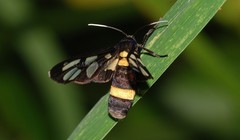Syntomoides imaon, a handmaiden moth, 伊貝鹿蛾
Syntomoides imaon (Cramer, 1780)Key Identification points . . . 3
Phenology 3
Adults recorded throughout the year, with peaks in March, May and October-November (as per figure 4, above)
Ecology 3
Found in most habitats from sea level to 570m elevation except dense urban or grassland areas .
Distribution in Hong Kong 3
Widespread: recorded throughout the New Territories and on the larger islands.
Systematics 3
Current binomial:Syntomoides imaon (Cramer, 1780)
Family: Erebidae (Owlet Moths)
Subfamily: Arctiinae (Tiger Moths)
Tribe: Syntomini (Handmaiden Moths)
Original genus: Ceryx
Current genus: Syntomoides
Species: imaon, described by: Cramer, 1780 Uitl. Kapellen 3 (17-21): 94, pl. 248, f. E
External link to citations, synonyms and original description
Holloway (Moths of Borneo, part 6) states the genus is monotypic, i.e. only contains the taxon imaon, though there appears to be quite a range of phenotypic variation over the wide geographic distribution, suggesting more than one species may be involved. There are many currently recognised synonyms.
Similar species 3
Amata sperbius
This species lacks the yellow "neck ring", has two dorsal hyaline cells on the forewing and the last thoracic segment has a yellow patch. The first abdominal segment has an incomplete yellow band. The hindwing hyaline cell is edged with yellow on the inside edge. Found in grassland habitats as well as open areas of forest.
Sources and Credits
- (c) Roger C. Kendrick, all rights reserved, uploaded by Roger C. Kendrick
- (c) carolkwok, some rights reserved (CC BY-NC)
- (c) Roger C. Kendrick, some rights reserved (CC BY-NC-ND)








